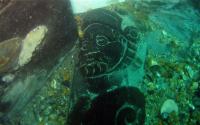
Wooden carving found on the wreck.
Two years ago we posted about the efforts by a Bournemouth University marine archaeology team to save the a mysterious ship known only as the Swash Channel Wreck, after its location off the Dorset coast. The team is now raising the ship’s 27ft, 2.4 tonne rudder, complete with Baroque carved face, to the surface for further study.
Despite the years of study and the recovery of over 1,000 artifacts, the identity of the 400 year old 130ft ship remains a mystery. More than 40 per cent of the ship survives, including parts of the ship’s forecastle, complete with galley and gunports.
The riddle of the 400-year-old shipwreck
An early suspect was the Spanish Armada vessel, San Salvador, lost in the area in 1588. However, it was eliminated after the tests dated the vessel’s timber frame to wood felled in 1628, from forests in the coastal region of the Netherlands-Germany border, near the modern city of Emden. Analysis of the artefacts suggest they came from the second quarter of the seventeenth century, giving experts a window of 1628 to 1650, during which the vessel was lost.
Ornate woodwork on the vessel, including four other baroque-style carvings recovered, mark it out as a high status vessel. It was also heavily armed, with 34 gun ports, but the design suggested it was not a warship. The galley was located in the bow castle, keeping the hull clear for cargo, indicating the vessel was an armed merchantman.
Frustratingly, there remains no sign on board of a possible cargo, suggesting it has either not survived almost four centuries on the seabed or was salvaged at the time.
However, the vessel’s hull did give one other crucial clue. Its outer layer is a sacrificial coating of pine and tar, applied to vessels involved in long distance trade, to be eaten by shipworm found in tropical waters.
The origin of the timber makes it most likely that the ship is Dutch, and some of the artefacts on board, including ceramics and a smoking pipe, hint at the same origin.
However, the team cannot rule out that the vessel could have been captured or purchased by another power, including Britain. Records of the Dutch East India Company provides no clues, nor do other archives checked so far.
Thanks to Alaric Bond for passing along the article.
